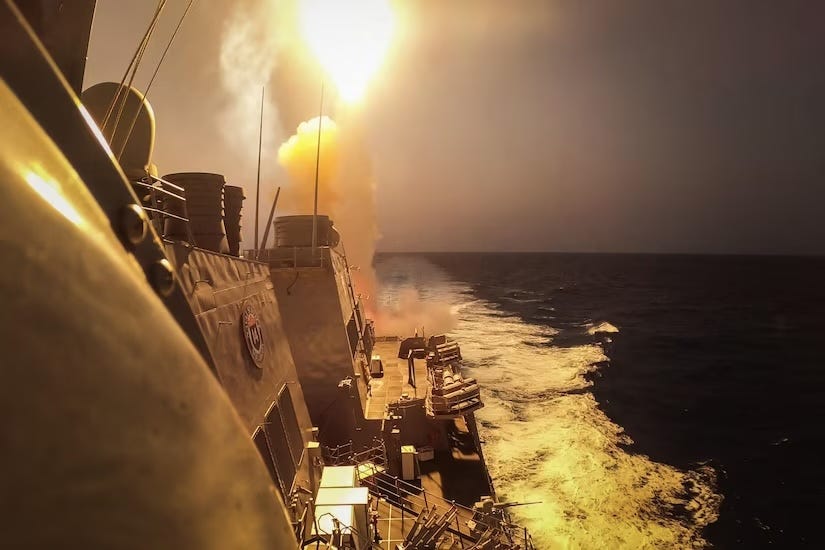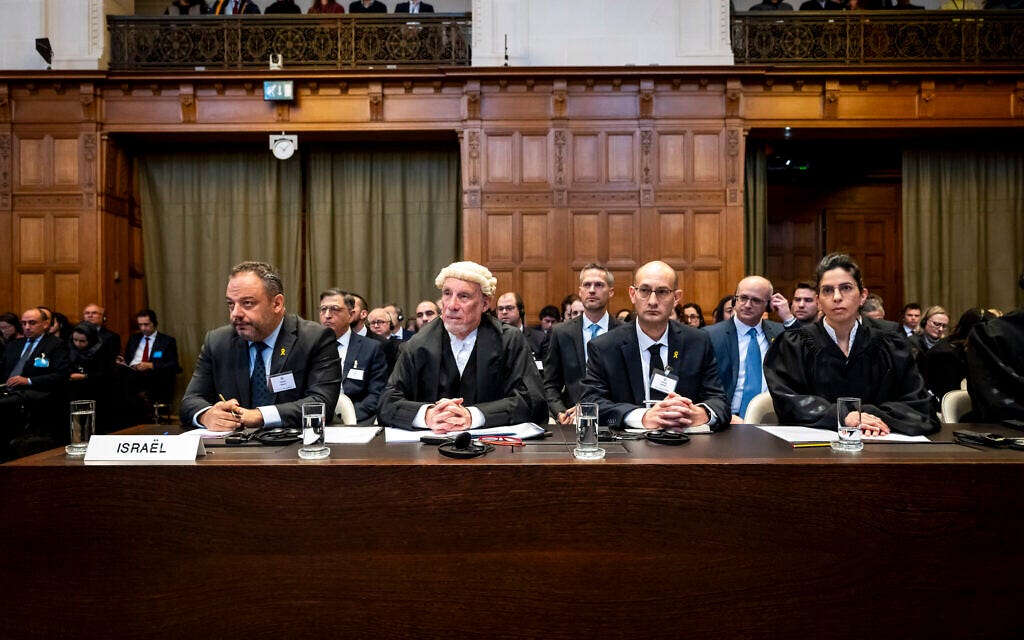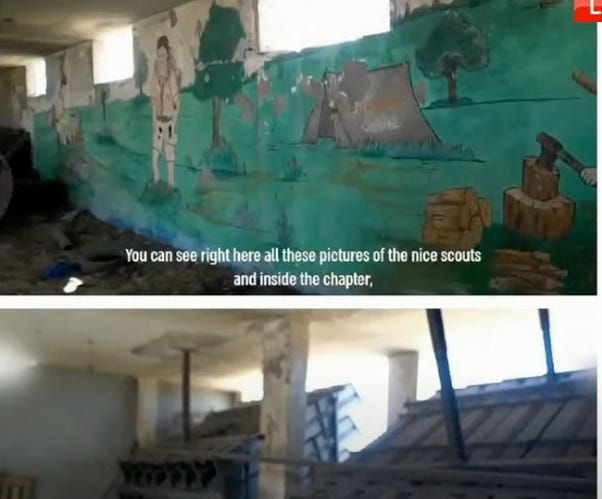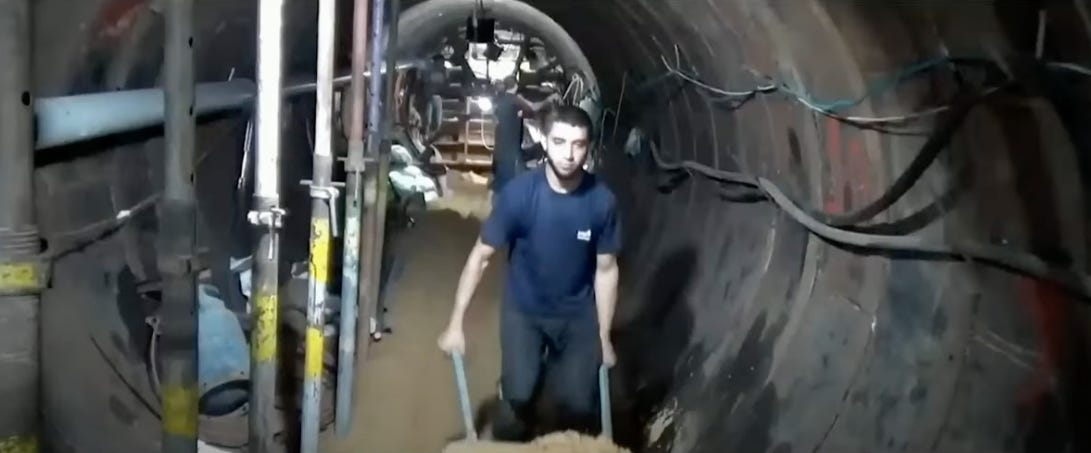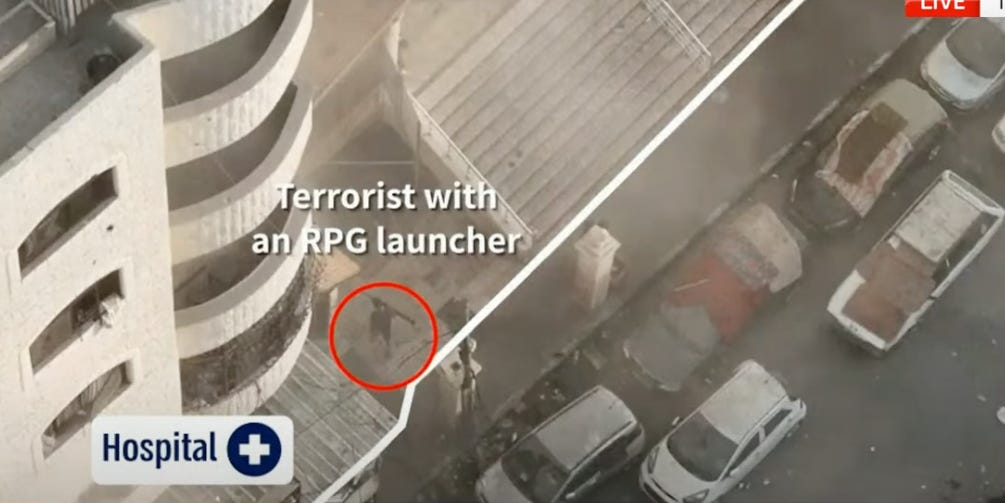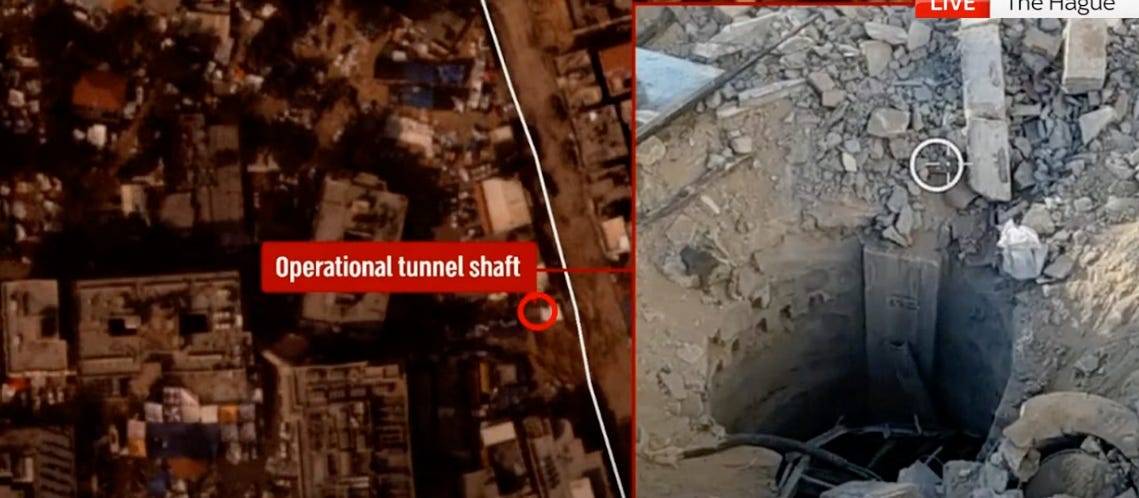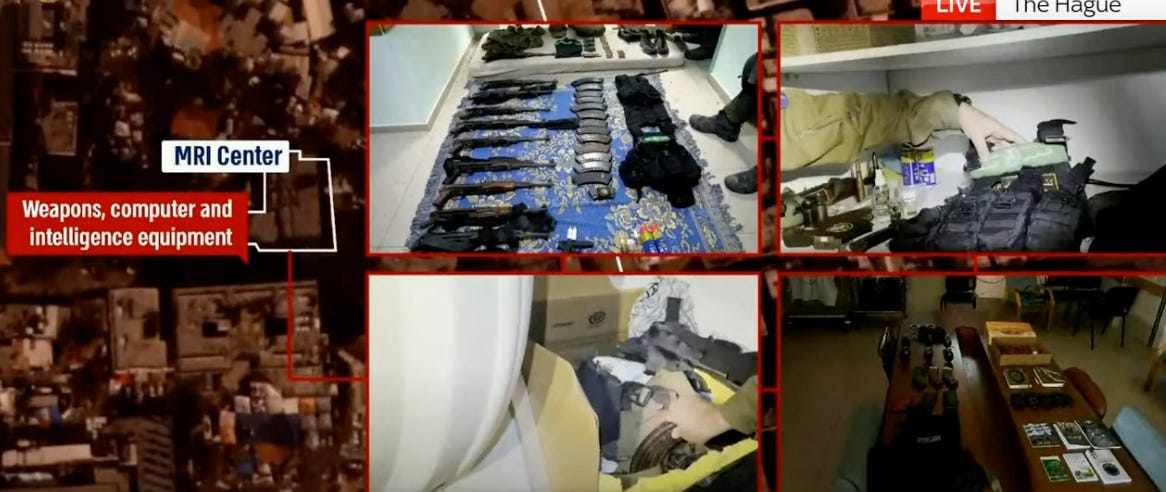DAY 99 OF THE GAZA WAR: US and UK Strike Houthis, Israel Defends Itself in The Hague, 120,000 Show Solidarity with Hostages in Tel Aviv
Tel Aviv Diary, January 14, 2024
US AND UK STRIKE HOUTHIS
On Thursday night, the United States and Great Britain launched a large-scale attack on the Houthis in Yemen. In the first wave of attacks, the US and Great Britain used a combination of aircraft and sea-to-land missiles, attacking over 60 targets, including: radar sites, anti-aircraft batteries, as well as storage sites for both missiles and drones. A second wave of allied strikes hit 40 targets later in the night. On Friday night, there was a third strike by a cruise missile at a radar site in Sana'a, the Houthi Capital. A fourth reported attack followed tonight
.
The Houthis have vowed to retaliate. The strikes received widespread Congressional approval in the US, including most Republicans. The only significant opponents were members of the Progressive wing of the Democratic Party, known as “The Squad”.
Israel naturally welcomed the attack on the Houthis. We were fortunate that the Houthis attacked ships of many origins, as well as, US Navy ships, and did not limit themselves to assaults solely to Israeli vessels. By firing nearly indiscriminately and targeting US Naval ships, the Houthis guaranteed an American response; a response that may be more effective than anything Israel might do.
It has been reported that two Navy Seals are missing after an undisclosed action off the coast of Somalia.
The question is, what next? Iran had threatened to close the Straits of Hormuz, if the US attacked the Houthis. I do not think the Iranians will go through with their threat. The last time they tried to close the Straits of Hormuz, 30 years ago, they lost half their Navy in a matter of hours.
IN THE NORTH
Both Friday and Saturday were relatively quiet days on the Lebanese Border. On Friday, 10 missiles were fired at various locations along the border. On Saturday, there was only one barrage of rockets fired. In both cases, the IDF returned fire.
BACK IN GAZA
Fighting continues in Gaza, both in the Central Camps and in the Khan Younis area. The Army is making efforts to cut off Khan Younis from the South, so as not to allow the escape of terrorists or hostages to Rafah. It seems a little late for that action, but better late than never.
On Friday, the Islamic Jihad fired a barrage of rockets that reached as far North as Ashdod. Then on Saturday, there were two small barrages aimed at the communities along our border with Gaza.
Here is a short announcement from the Army spokesman on part of the fighting:
In El Ma'azi, the brigade combat teams operating under the command of Division 36 have eliminated about 20 terrorists during the last day and discovered many weapons. Among the terrorists eliminated was a commander in the Nukhba force of the Hamas terrorist organization.
NEARLY 100 DAYS …
Tomorrow marks 100 days since the start of the war, and 100 days of captivity for the hostages. Tonight, a massive demonstration took place at Hostage Square in Tel Aviv. It’s estimated that 120,000 people took part. The hostage community has created a reconstruction of a Hamas tunnel to allow visitors to understand better where the hostages are being kept.
A smaller demonstration will take place over the next 24 hours. There will be a 100-minute strike of all workers tomorrow in solidarity with the hostages.
Earlier this evening there was a demonstration of about 10,000 people, demanding early elections for a new Knesset.
TEENAGE TERRORISTS ATTACK IN HEBRON HILLS
On Friday night, a group of three Palestinian teenage terrorists infiltrated the isolated settlement of Adora, in the Hebron Hills. One soldier who was patrolling the perimeter of the settlement was wounded. All three terrorists, none of whom have any record of prior terror activity, were killed by army troops who responded to the incident.
RISING TENSIONS IN THE WEST BANK
In a related development, the Security Services reportedly have issued an urgent warning to the Prime Minister about the potential for renewed violence in the West Bank. The Shin Bet has cautioned that the prohibition against West Bank workers entering into Israel, thus cutting many families off their source of income. The ban against West Bank workers, coupled with the ongoing dispute with the Palestinian Authority over payments to PA employees in Gaza (supporters on Hamas and their October 7 massacre), has created acute economic distress that could trigger a surge in violence.
INTERNATIONAL COURT OF JUSTICE (ICJ)
Friday, it was Israel’s turn to respond to the charges that it was committing genocide in Gaza.
Dr. Tal Becker, legal advisor of Israel’s Foreign Ministry, initiated Israel's defense by stating that South Africa has put forward “a profoundly distorted factual and legal picture.”
Dr. Becker emphasized, “The entirety of its case hinges on a deliberately curated, decontextualized, and manipulative description of the reality of current hostilities." He asserted that Israel’s military engagements in Gaza are self-defensive responses to Hamas and “other terrorist organizations.” Becker criticized South Africa for attempting “to thwart Israel's inherent right to defend itself,” and he cited the “strong relations” between South Africa and Hamas— which continued even after October 7th.
Furthermore, Dr. Becker recounted the events of October 7th, detailing the “wholesale massacre, mutilation, rape, and abduction” by Hamas. Dr. Becker concluded by stating that “if there were acts of genocide, they have been perpetrated against Israel.”
Next Came British International legal expert, Prof. Malcolm Shaw, who stated: “Every conflict is not synonymous with genocide.” In his continued defense of Israel, Prof. Shaw emphasized the risk of trivializing the weighty term, noting, "If accusations of genocide become commonplace, the essence of this crime would be diluted and lost.”
Prof. Shaw criticized South Africa for not allowing Israel an adequate opportunity to address the allegations made against it. Shaw further aimed to debunk South Africa's assertion that “genocidal intent” on Israel's part is evident in selected statements from lawmakers and public figures. Prof. Shaw asserted that “picking out random quotes, which do not align with the government's policy, is at best misleading.” Shaw maintained that these quotes do not reflect the decisions and actions of Israel's war cabinet.
In the next presentation, Dr. Galit Raguan, Acting Director of the International Justice Division at Israel’s Justice Ministry asserted that “measures taken by the IDF intended to mitigate harm to the civilian population” are evidence of Israel's lack of intent to commit genocide. Raguan further emphasized “the sheer extent to which Hamas uses ostensibly civilian structures for military purposes.”
Dr. Raguan indicated that over 23,000 fatalities have occurred due to Israeli strikes since October 7, acknowledging that “urban warfare will always result in civilian harm.” Raguan argued that these deaths, though regrettable, might be a legitimate outcome of targeting military objectives, and should not be confused with genocide. She pointed out that civilian casualties are greatly increased due to Hamas’s practice of operating within civilian locations, such as schools and hospitals.
Additionally, Dr. Raguan contended that the IDF has discovered indications of Hamas military activities inside every hospital in the Gaza Strip. These findings were made through precise special forces operations, contradicting Palestinian claims of indiscriminate bombing of medical facilities.
Raguan asserted that
Urban warfare will always result in tragic deaths, harm, and damage, but in Gaza, these undesired outcomes are exacerbated because they are the desired outcomes of Hamas. In urban warfare, civilian casualties may be the unintended but lawful result of attacks on lawfully military objectives. International humanitarian law recognizes this reality and provides a framework for balancing military necessity with humanitarian considerations.
These do not constitute genocidal acts. In the current conflict, many civilian deaths are directly caused by Hamas. Booby-trapped homes detonate and kill indiscriminately, mines in alleyways collapse structures around them, and over 2,000 rockets misfired by Hamas have landed inside Gaza, causing untold levels of harm.
One telling example is a blast at the Al Hali Hospital on October 17. Hamas claimed that the Israel Defense Forces, the IDF, attacked the hospital. Headlines around the world rushed to repeat this claim. The IDF later proved, and U.S. intelligence and other national security intelligence agencies independently confirmed, that the blast was the result of a failed launch from within Gaza. It was not, as Hamas claimed, the fault of the IDF.
Next advocate on behalf of Israel, was Dr. Christopher Staker, a British Barrister who had been Head of the Legal Department at ICJ, early career in his career. Dr. Staker methodically addressed each of the nine legal arguments presented by South Africa, arguing that the proposed request was designed to protect Hamas from Israel's retaliation for the atrocities committed on October 7th. He suggested that endorsing this defense could potentially embolden the terrorist group to carry out similar acts in the future.
Dr. Staker asserted:
Implementing provisional measures would hinder Israel's ability to defend its citizens. This could lead to more individuals being attacked, raped, and tortured by Hamas. Provisional measures would also prevent Israel from taking any action.
Staker further explained:
If approved, this would imply that when a recognized terror group carries out terrorist attacks against another state, a third party's request for provisional measures could obstruct a nation's right to self-defense.
He concluded,
The unavoidable casualties and human suffering inherent in any conflict do not, by themselves, indicate a genocidal intent. Therefore, these provisional measures fall outside the scope of the court's statutes, he declared.
The final representative for Israel was Dr. Gilad Noam, Deputy Attorney General for International Affairs at the Israeli Justice Ministry. Dr. Noam emphasized the court's lack of “prima facie jurisdiction," attributing this to South Africa's failure to adhere to the requisite diplomatic and bureaucratic protocols. He warned the court that endorsing South Africa's claims might inadvertently empower terrorist organizations, thereby shielding them from accountability for future crimes against humanity, similar to those committed by Hamas on October 7.
Noam stated:
By considering the applicant's plea, we risk diminishing the efforts to combat genocide. Instead of the court serving as a bulwark against terrorist atrocities, it risks being manipulated as a tool by terrorist groups who blatantly disregard humanity and the rule of law.
Dr. Noam further argued that acceding to South Africa's plea for provisional measures "would send a message to terrorist groups that they can perpetrate war crimes and crimes against humanity, then seek refuge under the auspices of this court.”
Regarding South Africa's application to the ICJ, Dr. Noam opined, “We are observing a deliberate and cynical attempt to distort the very definition of genocide.” Dr. Noam concluded, “The trust placed in international law is a precious resource that should not be wasted. We urge the court to avoid this perilous path.”
The Court is anticipated to announce its interim decision, if any, within the coming week. Following the conclusion of the two-day hearing, Israeli observers expressed optimism, believing that the court is unlikely to issue a ruling demanding an end to the conflict. Additionally, Germany has declared its intention to submit a motion as an amicus curiae, or 'friend of the court', in support of Israel's stance during the adjudication of the broader case.
SOUTH AFRICAN CRICKET ASSOCIATION
The South African Cricket Association has decided to relieve David Teeger of his captaincy role within the team. This decision follows his public expression of pro-Israeli sentiments. The Association cited concerns that Teeger's presence as captain, especially given his Jewish heritage, could potentially incite protests against the team.
The following is the full text of the presentation by Dr. Galit Raguan, Acting Director of the International Justice Division at Israel’s Justice Ministry, I thought the best presentation by the Israeli Team":
The rights asserted by South Africa, plausibility cannot be determined based on the unsubstantiated allegations of one party to the proceedings alone. If Article 41 of the court statute is to have any meaning, in the time available, I will address three aspects of reality on the ground that the applicant has either ignored or misrepresented. First, Hamas's military tactics and strategy; second, Israel's efforts to mitigate civilian harm during operational activity; and third, Israel's efforts to address humanitarian hardship in Gaza despite Hamas's attempts at obstruction. With respect to Hamas's military tactics and strategy, it is astounding that in yesterday's hearing, Hamas was mentioned only in passing, and only in reference to the October 7 massacre in Israel. Listening to the presentation by the applicant, it was as if Israel is operating in Gaza against no armed adversary. But the same Hamas that carried out the October 7 attacks in Israel is the governing authority in Gaza, and the same Hamas has built a military strategy founded on embedding its assets and operatives in and amongst the civilian population. Urban warfare will always result in tragic deaths, harm, and damage, but in Gaza, these undesired outcomes are exacerbated because they are the desired outcomes of Hamas. In urban warfare, civilian casualties may be the unintended but lawful result of attacks on lawfully military objectives. International humanitarian law recognizes this reality and provides a framework for balancing military necessity with humanitarian considerations. These do not constitute genocidal acts. In the current conflict, many civilian deaths are directly caused by Hamas. Booby-trapped homes detonate and kill indiscriminately, mines in alleyways collapse structures around them, and over 2,000 rockets misfired by Hamas have landed inside Gaza, causing untold levels of harm. One telling example is a blast at the Al Hali Hospital on October 17. Hamas claimed that the Israel Defense Forces, the IDF, attacked the hospital. Headlines around the world rushed to repeat this claim. The IDF later proved, and U.S. intelligence and other national security intelligence agencies independently confirmed, that the blast was the result of a failed launch from within Gaza. It was not, as Hamas claimed, the fault of the IDF. Damage to civilian structures is another fact claimed by South Africa as evidence of genocide, but South Africa does not consider the sheer extent to which Hamas uses ostensibly civilian structures for military purposes. Houses, schools, mosques, UN facilities, and shelters are all abused for military purposes by Hamas, including as rocket launching sites. Hundreds of kilometers of tunnels dug by Hamas under populated areas in Gaza often cause structures above to collapse. In the slides before you, you can see a militant climbing projectiles for launch on IDF forces in Gaza. You can see the holes in the residential house to hide and launch them.
Here, you can see projectiles discovered underneath the bed in a child's bedroom.
Here, a rocket being fired from a school, the launch site that's circled in red.
Here, you can see firing from a UN school. You can see the letters 'UN' on the roof, and the fire is circled in red.
And here, long-range rocket launchers hidden inside a scouts club building.
Finally, you can see part of a tunnel that runs for four kilometers, including nearby the Erez crossing, which is adjacent to Israel.
Gaza's infrastructure has certainly been harmed during the conflict. However, South Africa would have the court believe that Israel is deliberately and unlawfully destroying homes without cause, but harm caused to lawful military objectives and harm caused as a result of Hamas's actions is not evidence of genocide. South Africa also alleges that Israel has waged an assault on Gaza's health system. What South Africa has neglected to bring before the court, however, is the overwhelming evidence of Hamas's military use of such hospitals. Hamas militants retreated to Rantissi Hospital in Gaza on October 7th with hostages from Israel, whom they then held in the basement. And the slide before you, you will see a militant going into quote 'hospital' with an RPG.
Hamas fired at IDF forces from near and from within the Cloud Hospital, Shifa Hospital, Gaza's largest. Hamas managed operations from a closed-off area. Here, you can see an opening to the tunnel that ran for hundreds of meters directly under the hospital.
Here, you can see the weapons found in different wings of the hospital,
and here, CCTV footage showing armed militants bringing hostages into the hospital's lobby. More than 80 militants hiding inside another hospital, the Aguan Hospital, surrendered themselves to the IDF. And here, you can see a weapon that IDF forces discovered hidden inside incubators at the hospital. The director of the hospital has admitted that numerous members of hospital staff belong to Hamas's military wing. And then, the Nesian Hospital in the neighborhood of Jabalia. Hamas forces managed their operations from that hospital until the IDF reached it. IDF forces recovered the bodies of five murdered hostages from a tunnel dug underneath the hospital. The list goes on. In every single hospital that the IDF has surged in Gaza, it has found evidence of Hamas military use. Israel is acutely aware that because of Hamas's use of hospitals as shields for its military operations, in grave violations of international humanitarian law, patients and staff are at risk. This is why the IDF has reached out to every hospital and offered assistance in relocating patients and staff to safer areas. Hospitals have not been bombed. Rather, the IDF sends soldiers to search and dismantle military infrastructure, reducing damage and disruption. Indeed, the tunnel that's directly under the main building in Shifa Hospital was exploded without damaging the building above. The IDF then withdrew from the hospital. Yes, damage and harm have occurred as a result of hostilities in hospitals' vicinity, sometimes by IDF fire, sometimes by Hamas, but always as a direct result of Hamas's abhorrent method of warfare. Israel has published plenty of evidence of the extensive misuse by Hamas of medical facilities, in direct violations of international humanitarian law. It has brought journalists to see first hand, it has recorded calls with hospital staffs to coordinate assistance. None of that is mentioned in the application. In fact, the applicant describes the result and asks the court to attribute malicious intent to Israel, but that is only a possible conclusion if one obscures, as the applicant has, Hamas's strategy of turning hospitals into terrorist compounds. The applicant also made much of the fact that force has been even used in humanitarian zones. What the applicant neglected to inform the court, however, was that Hamas has, and its contempt for Palestinian civil life, regularly and deliberately fired from such zones, turning areas of relief into zones of conflict. Here before you, you can see one example of a launch site adjacent to the humanitarian zone, both amplified and larger pictures. And in the next slide, you can see evidence of a rocket launched from next to Gaza's water desalinization facility. I now would like to address briefly the second issue: Israel's efforts at mitigation of civilian harm. Here too, the applicant tells not just a partial story, but a false one. For example, the application presents Israel's call to civilians to evacuate areas of intensive hostilities quote 'as an act calculated to bring about its physical destruction' quote. This is a particularly egregious allegation that is completely disconnected from the governing legal framework of international humanitarian law. Evacuation of civilians is recognized under international humanitarian law as one of the measures that may be implemented to protect civilians from the effects of ongoing hostilities. Indeed, such evacuation may even amount to a duty that the party to the conflict has toward civilians. While temporary evacuation undoubtedly involves hardship and suffering, it is preferable to remaining in areas of intensive hostilities, all the more so when one party makes a concerted effort to use those civilians as shields. The IDF maintains a civilian harm mitigation unit to undertake this task. It works full time to provide advanced notice of areas in which the IDF intends to intensify its activities, coordinate travel routes for civilians, and secure these routes. This unit has developed a detailed map so that specific areas can be temporarily evacuated instead of evacuating entire areas. On the slide before you, you can see that map divided into areas, as well as a screenshot of a video explaining the system in Arabic so civilians may understand. IDF also enacts localized pauses in its operations to allow civilians to move, and does this even though Hamas does not agree to do the same and has even attacked IDF forces securing humanitarian corridors. Excuse me, I have a request from the interpreters that you slow down the pace of your speaking. Could you please do that? Thank you. Yesterday, South Africa stated that the IDF gave 24 hours' notice to civilians in northern Gaza to evacuate. In fact, the IDF urged civilians to evacuate to southern Gaza for over 3 weeks before it started its ground operation. Three weeks that provided Hamas with advanced knowledge of where and when the IDF would be operating. This three-week period for temporary evacuation is a matter of common knowledge, and the applicant's misrepresentation of this fact is at best an unfamiliarity with the events, and at worst a desire to tailor its story to a pre-existing narrative. The IDF employs a range of additional measures in accordance with the obligation to take precautionary measures under international humanitarian law. For example, it provides effective advanced warnings of attacks where circumstances permit. To date, the IDF has dropped millions of leaflets over areas of expected attacks with instructions to evacuate and how to do so, broadcast countless messages over radio and through social media, warning civilians to distance themselves from Hamas operations, made over 70,000 individual phone calls, including to occupants of the target, warning them of impending attacks. This requires time, it requires resources and intelligence, and the IDF invests all of these to save civilian lives. Here, you can see the IDF's Arabic Twitter account providing information for civilians to evacuate specific areas, including the location of shelters nearby.
"Yet, the applicant astonishingly claims that these efforts are, in themselves, genocidal. In other words, a measure intended to mitigate harm to the civilian population, sometimes exceeding the requirements of international humanitarian law, is proof, according to the applicant, of Israel's intent to commit genocide. When, in fact, it proves the exact opposite.
My third topic, with respect to the humanitarian situation, much attention was given by South Africa to this situation. Despite Israel's efforts to mitigate harm, there is no question that many civilians in Gaza are suffering as a result of the war that Hamas began. While Israel is seeking to minimize civilian harm, Hamas is doing everything in its power to use the civilian population and civilian infrastructure for its own protection, flouting humanitarian efforts aimed at alleviating the distress of the civilian population.
Further illustration of Hamas's tactics and Israel's efforts can be found in Taps 4 and 9 of the volume provided to the court. I now turn to describe just some of the humanitarian coordination efforts that Israel has been engaged in, and Mr. Sender will further expand on this.
Israel maintains a dedicated military unit called COGAT, responsible for routine coordination with international organizations in Gaza with respect to various humanitarian aspects. It is COGAT that mans and operates the crossings between Israel and Gaza. This includes the Erez Crossing, through which, prior to October 7, almost 20,000 Gazans passed through into Israel daily for work. South Africa showed up yesterday with the Erez Crossing marked closed. What it failed to note is that the crossing was attacked on October 7th by Hamas, which murdered and kidnapped COGAT staff and caused significant damage. Here you can see some of that damage.
Nevertheless, COGAT works around the clock to fulfill its role. Its large, professional staff works on numerous initiatives, of which I will only mention a few. First, COGAT manages a mechanism by which it maintains an up-to-date picture of the needs in Gaza. It does this with the UN, other international organizations, and states' representatives who sit in COGAT's offices. COGAT uses this monitoring to help donor states and organizations prioritize their aid efforts to fit the evolving situation on the ground.
Second, COGAT facilitates the entry of aid into Gaza. Israel, as publicly stated repeatedly, has no limit on the amount of food, water, shelter, or medical supplies that can be brought into Gaza. To increase capacity, COGAT has reopened the Kerem Shalom Crossing, as acclaimed by the Security Council in Resolution 2720. Despite Hamas putting it under fire, Israel has offered to extend operating hours at the crossing if there is the capacity to receive the goods by international organizations on the Gaza side.
Third, COGAT works to reinforce and strengthen medical services. COGAT has facilitated the huge logistical challenge of establishing four field hospitals in Gaza, and more are being set up, and two floating hospitals. It has facilitated the entry of new ambulances into Gaza, and Israel has even coordinated air drops of aid over Gaza by Jordan, coordinating these flights with the Israel Air Force operating in Gaza.
This, of course, is not to say that nothing more can be done, or that there are no challenges to the humanitarian situation in Gaza. Such challenges exist and change according to the evolving circumstances of the conflict. But it is to say that the charge of genocide, in the face of these extensive efforts, is frankly untenable. That is an inconvenient truth for the applicant's case.
But one of the most significant challenges is the fact that Hamas commandeers consignments into Gaza and controls their distribution. Gazan residents have reported that Hamas is regularly stealing aid at the expense of its own population, for the benefit of its fighters. This is a tweet stating that fuel and medical equipment was stolen by purported Hamas members from an UNRWA warehouse.
Unrelated, it was later deleted, perhaps under pressure from the authorities. Here you can see Hamas commandeering an aid truck, and here is another example.
Because Hamas, for years, has used consignments to smuggle weapons, security checks of all goods going into Gaza are required, as acknowledged by international humanitarian law. Hamas has time and again hoarded fuel, including during the current conflict, which it uses for military purposes, to sustain ventilation in its expansive underground tunnel network, and for its continued attacks against Israel. Nevertheless, in coordination with the UN, Israel enables fuel to enter Gaza to service essential infrastructure, such as sewage treatment, desalinization plants, water pumps, and hospitals, and cellular infrastructure for maintaining communication.
Israel remains committed to helping international organizations and states involved in the aid effort to overcome these hurdles and consistently increase the amount of aid and services available to the population in Gaza, as will be further described by Mr. Sender.
Here, a picture of incubators that the IDF provided to Shifa Hospital. Here, a picture of an ambulance convoy coordinated by COGAT.
A picture of consignments. A picture of ambulances, the entry of which was coordinated by COGAT. And finally, more consignments waiting to enter Gaza.
Madam President, members of the court, in the time allotted, I have been able to describe only some of Israel's efforts to mitigate civilian harm and to address the humanitarian situation in Gaza. But even this mere fraction is enough to demonstrate how tendentious and partial the applicant's presentations of these facts is, and certainly enough to conclude that the allegation of intent to commit genocide is baseless.
If Israel had such intent, would it delay a ground maneuver for weeks, urging civilians to seek space for space, and in doing so, sacrificing operational advantage? Would it invest massive resources to provide civilians details about where to go, when to go, how to go to leave areas of fighting? Would it maintain a dedicated unit staffed with experts, whose sole role is to facilitate aid, and who continue to do so despite having their staff killed and kidnapped?
When a population is ruled by a terrorist organization that cares more about wiping out its neighbor than about protecting its own civilians, there are acute challenges in protecting the civilian population. Those challenges are exacerbated by the dynamic and evolving nature of intense hostilities in an urban area, where the enemy exploits hospitals, shelters, and critical infrastructure.
Would Israel work continuously with international organizations and states, even reaching out to them on its own initiative, to find solutions to these challenges if it were seeking to destroy the population? Israel's efforts to mitigate the ravages of this war on civilians are the very opposite of intent to destroy them.
Under these circumstances, far from being the only inference that could reasonably be drawn from Israel's pattern of conduct, intent to commit genocide is not even a plausible inference.
Madam President, members of the court, that concludes my statement. I thank you for your kind attention, and I ask that you now invite Mr. Sander to the podium."




